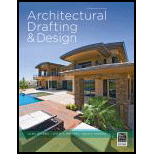
To define and give two other names for a set of architectural drawings.
Explanation of Solution
Architectural drawing is a special kind of drawing in which an architect lay out the future projects on paper. When you draw a building on paper it’s a 3D-represenattion. Since the architectural drawing requires showing the inner view, outer view, top views, etc. The project is accomplished as per the architectural drawing only. Therefore the architectural drawing requires a special kind of scale. Lots of graphics, symbols and projections are used in architectural drawing.
Advantages of architectural drawing:
The architectural drawing showcases the actual concept of any building/bridge/road or any project on paper. The drawing helps effectively communicate the idea. Once you have a design on paper only then it can be represented anywhere for business proposal or to sign a contract or for the record.
Significant element of architectural drawing:
Since the architectural drawing showcases the actual concept of any building/bridge/road or any project on paper. Therefore, to accomplish this task, the designer needs some special elements in drawing for effective representation on the paper. The special elements of architectural drawings includes site plan, section or part wise plan of the project, elevation, details of each elements, Isometric and axonometric projections, top view, inner view, outer view, etc.
Kinds of Architectural Drawing-
Survey Drawings- These are used to showcase the existing land dimensions, its area, the level of the projectsites, soundings, and any other exiting construction that can create problem in smooth execution of work on the site.- Presentation Drawing- These are an illustration of design ideas to visualize the actual design.This drawing may include real life scenarios.
- Working Drawing- The working diagram is the actual diagramwhich are used for the actual execution of work.
Other names for a set of architectural drawings are technical drawings and structural drawing.
Want to see more full solutions like this?
Chapter 2 Solutions
Architectural Drafting and Design (MindTap Course List)
- Calculate ALL nodal displacements and ALL the member forces in the truss. Please use the ID's noted in the truss diagramarrow_forwardQ3. In a water flood operation in reservoir A, water is being distributed to severalinjection wells from a common injection system; that is, water is supplied to all thewells at approximately the same well head pressure. Routine measurement of theindividual well injection rates by the team of field operators showed that one well wasreceiving approximately 45% more than its neighbours. The sum of the kh productsfor all of the injection wells were approximately the same depth. As a member of theteam, explain:What are the possible causes of the abnormally high injection rate in this well, andwhat production logs or other tests might be run to further diagnose the problem andplan remedial action?arrow_forwardQuestion 1 20 pts Test data on the bending strength of construction wood poles of various diameter are presented below assuming the same length. Kip- 1000 lbf. Using the following data with 2nd order Newton polynomial interpolation, we want to determine the strength of the material for x=4.5 in. Which data point will be used as x? After you found x0, enter the value of x-xo in the solution. Answer shall be in one decimal place. Distance (in) 2.6 1.5 8.3 2.8 5.7 Strength (kips) 100 200 300 400 500arrow_forward
- Solve pleasearrow_forwardsolve all of the last names from A-K to please for example use k=100k/in , m =1000lb/g . use el centro (2nd picture ) to solve the questions. Thank you for your help! for the following questions ignore that last name and just solve it pleae: Verify the modes that are orthogonal Normalize the first mode uisng electro with 2%damping, Determine Sa&Sd only for the first modearrow_forwardFor question 2 do 2% please. Use El centro spectrum to answer the secon question please. Thank you for your help!arrow_forward
- solve pleasearrow_forwardA mechanism for pushing small boxes from an assembly line onto a conveyor belt is shown with arm OD and crank CB in their vertical positions. For the configuration shown, crank CB has a constant clockwise angular velocity of 0.6π rad/s. Determine the acceleration QE of E (positive if to the right, negative if down). 450 mm 215 mm 565 mm A 185 mm 105 mm 110185. mm mm Answer: a = i B 40 mm E m/s²arrow_forwardPlease answer the following questions in the picture, use the second picture to answer some of the questions. I appreciate your help! Explain step by step, thank you!arrow_forward
- Question 5. Three pipes A, B, and C are interconnected as in Fig. 2. The pipe characteristics are given below. Find the rate at which water will flow in each pipe. Find also the pressure at point P. (Neglect minor losses) Pipe D (in) L (ft) f A 6 2000 0.020 B 4 1600 0.032 C 8 3000 0.02 -El. 200 ft P -El. 120 ft B Fig. 2 -El. 50 ft.arrow_forwardcalculate all nodal displacementts and all the member forces of the trussarrow_forwardNOTE: Use areal methods only for V,M,N diagrams(Do NOT use the equations) (also draw the N diagram(s) for the entire structure)arrow_forward
 Architectural Drafting and Design (MindTap Course...Civil EngineeringISBN:9781285165738Author:Alan Jefferis, David A. Madsen, David P. MadsenPublisher:Cengage Learning
Architectural Drafting and Design (MindTap Course...Civil EngineeringISBN:9781285165738Author:Alan Jefferis, David A. Madsen, David P. MadsenPublisher:Cengage Learning Engineering Fundamentals: An Introduction to Engi...Civil EngineeringISBN:9781305084766Author:Saeed MoaveniPublisher:Cengage Learning
Engineering Fundamentals: An Introduction to Engi...Civil EngineeringISBN:9781305084766Author:Saeed MoaveniPublisher:Cengage Learning Construction Materials, Methods and Techniques (M...Civil EngineeringISBN:9781305086272Author:William P. Spence, Eva KultermannPublisher:Cengage Learning
Construction Materials, Methods and Techniques (M...Civil EngineeringISBN:9781305086272Author:William P. Spence, Eva KultermannPublisher:Cengage Learning Fundamentals Of Construction EstimatingCivil EngineeringISBN:9781337399395Author:Pratt, David J.Publisher:Cengage,
Fundamentals Of Construction EstimatingCivil EngineeringISBN:9781337399395Author:Pratt, David J.Publisher:Cengage,



